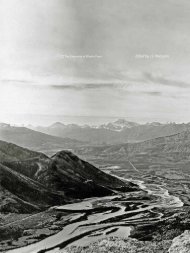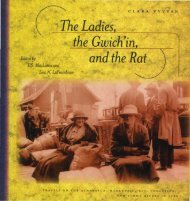Paul Kane's Journal of his Western Travels, 1846-1848 - History and ...
Paul Kane's Journal of his Western Travels, 1846-1848 - History and ...
Paul Kane's Journal of his Western Travels, 1846-1848 - History and ...
Create successful ePaper yourself
Turn your PDF publications into a flip-book with our unique Google optimized e-Paper software.
Guide to People <strong>and</strong> Places in <strong>Kane's</strong> <strong>Journal</strong><br />
I. s. MacLaren<br />
The entries are ordered alphabetically by the first spelling Kane<br />
uses. Any references to the book, W<strong>and</strong>erings o!an Artist among<br />
the Indians <strong>of</strong> North America, are cited as WA ; the page references<br />
refer to the same edition cited in the author's essay. All<br />
references to the Hudson's Bay Company have been shortened to<br />
HBC. Finally, dates given for the establishment <strong>of</strong> forts refer to<br />
the first date when any fort existed at the location. After 1821, all<br />
forts listed were operated by the HBC.<br />
Alax<strong>and</strong>er / Alex<strong>and</strong>er See Fort Alax<strong>and</strong>er / Fort Alex<strong>and</strong>er.<br />
Asneboin, Frot See Frot Asneboin.<br />
Asneboin river The Assiniboine River flows into the Red<br />
River at the modem city <strong>of</strong> Winnipeg, Manitoba (Upper Fort<br />
Garry in <strong>Kane's</strong> day). It stretches 660 miles, flowing eastward<br />
across the prairies from southeastern Saskatchewan.<br />
Although a principal route onto the prairie, the Assiniboine<br />
did not fonn part <strong>of</strong> the transcontinental fur trade water route.<br />
Asneboins/ Asne boins The Assiniboine tribe, which received<br />
its name from an Ojibwa word for "boiling food by dropping<br />
heated rocks into containers <strong>of</strong> water, " had an original homel<strong>and</strong><br />
around the Mississippi headwaters, but by the 1840s had<br />
long been settled northwestward, in the vicinity <strong>of</strong> Lake <strong>of</strong><br />
the Woods <strong>and</strong> Lake Winnipeg. During the height <strong>of</strong> the fur<br />
trade, Assiniboine were noted for their pemmican production,<br />
<strong>and</strong> for their role as middlemen, trading European<br />
goods to the distant Plains tribes. In t<strong>his</strong> way, their territory<br />
spread west, up the Saskatchewan, Assiniboine, Milk, <strong>and</strong><br />
Missouri river Valleys . Their allies were the Cree, <strong>and</strong> their<br />
adversaries the Blackfoot, Gros Ventres, <strong>and</strong> Sioux (Dakota).<br />
Numbering as many as 10,000, they declined rapidly with the<br />
onset <strong>of</strong> European diseases such as smallpox.<br />
(Astoria), man with the tin box Kane here refers to Astorian<br />
John Reed, an Irish clerk in the Pacific Fur Company, which<br />
New York merchant John Jacob Astor founded in 1809. In<br />
1810 he sent two expeditions, one by ship <strong>and</strong> one overl<strong>and</strong><br />
by boat, to establish a fur trade post at the mouth <strong>of</strong> the<br />
Columbia River (at modem Astoria, Oregon). Kane errs in<br />
claiming that Reed was shot at the Chutes on the Columbia<br />
River. Chinook did attack Reed, on the portage at the Dalles;<br />
they did so because, according to Washington Irving, "the<br />
unlucky tin box" in which Reed was carrying dispatches<br />
from Fort Astoria, at the mouth <strong>of</strong> the Columbia River, to<br />
Astor, in New York, "shining afar like the brilliant helmet <strong>of</strong><br />
Euryalus, caught their eyes." On t<strong>his</strong> occasion, Reed "received<br />
a blow on the head with a war club that laid him<br />
senseless [but not dead] on the ground. " The next year, in the<br />
summer <strong>of</strong> 1813, Reed was, in fact, slain by Indians. His<br />
death occurred at a dwelling he had built on the Snake River,<br />
upriver from its confluence with the Columbia.<br />
Athabasca, the river ie / Atbabaskia T<strong>his</strong> is the southernmost<br />
headstream <strong>of</strong> the Mackenzie River <strong>and</strong> Arctic Ocean drain-<br />
66<br />
age system. Starting at the Columbia Icefield in Jasper National<br />
Park (on the British Columbia/ Alberta border), it<br />
flows northeast for 7(J) miles across the province <strong>of</strong> Alberta<br />
to Lake Athabasca. As a fur trade route, it provided access<br />
from the prairies to the Columbia River, via Athabasca Pass,<br />
on the extreme southwest boundary <strong>of</strong> the park.<br />
aux Chene See Point <strong>of</strong> Woods.<br />
Bareings river See Lake Winapeg.<br />
Barriere portage Kane portaged around the Barrier Falls on<br />
the Winnipeg River, 112 miles downstream from Lake <strong>of</strong> the<br />
Woods, on June 10, <strong>1846</strong>, <strong>and</strong> August 9, <strong>1848</strong>. The site today<br />
is mistakenly called Sturgeon Falls.<br />
Bateseis River Known in the fur trade period as the Baptiste<br />
River, today t<strong>his</strong> tributary <strong>of</strong> the Athabasca River is called<br />
Berl<strong>and</strong> River. Both names refer to an early trader, Baptiste<br />
Berl<strong>and</strong>. The Berl<strong>and</strong> enters the Athabasca from the north,<br />
about 130 miles downstream from where the Athabasca Pass<br />
trail brought the fur brigades to the Athabasca River.<br />
Belcour, Mr. George-Antoine Bellecourt (also Bellecours,<br />
Belcourt) ( 1803 -1874), a Roman Catholic priest <strong>and</strong> missionary<br />
from Lower Canada, started several missions in 1840,<br />
including the one at Wabassimong, on the Winnipeg River<br />
(today's White Dog, Ontario). The mission had failed by the<br />
time <strong>of</strong> <strong>Kane's</strong> return trip, principally because, like so many<br />
others, Bellecourt attempted to use agriculture <strong>and</strong> a policy <strong>of</strong><br />
permanent residence to convert nomadic tribes to Christianity.<br />
big dog poartage T<strong>his</strong> scenic portage led fur trade brigades<br />
from the Kaministikwia River to Big Dog or Great Dog Lake,<br />
<strong>and</strong> thence to the height <strong>of</strong> l<strong>and</strong> between the Lake Superior<br />
<strong>and</strong> Lake Winnipeg (Hudson Bay) watersheds. The name<br />
derives from an Indian effigy <strong>of</strong> an oversized dog, which was<br />
located on the portage atop a 400-foot hill that overlooked the<br />
Kaministikwia River valley; hence <strong>Kane's</strong> description,<br />
"verry beautifull.' ,<br />
Black feet / Blackfoot / Blackfeete Blackfoot are the smallest<br />
<strong>of</strong> the three tribes (Blood <strong>and</strong> Peigan are the others) <strong>of</strong> the<br />
Blackfoot Nation, <strong>and</strong> occupied hunting grounds north <strong>of</strong> the<br />
other two, in the Battle <strong>and</strong> Red Deer river valleys <strong>of</strong> modem<br />
central Alberta. Numbering between 2000 <strong>and</strong> 3000 in <strong>Kane's</strong><br />
day, they were bison hunters <strong>and</strong> warriors, the principal<br />
enemies <strong>of</strong> the Cree <strong>and</strong> Assiniboine.<br />
boat-incampment/boat incumpment/Boat in campment/<br />
Coumpmont de Barge Boat Encampment was established<br />
in 1811 by David Thompson, the North West Company<br />
explorer, fur trader, <strong>and</strong> cartographer. Located at the northernmost<br />
bend <strong>of</strong> the Columbia River (in modem British<br />
Columbia), it served for more than fifty years as the rendezvous<br />
for brigades coming up the Columbia from the Pacific<br />
by canoe. <strong>and</strong> those coming from the prairies through<br />
Guide
















